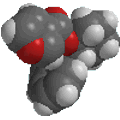| Chapter 1: Structure Determines Properties |
| Chapter 1: Structure Determines Properties |
Each type will be encountered during our journey through organic chemistry.
Ionic
bonds result when
electrons are transfered between atoms forming ions.
The electron donor will become a positively charged ion = cation
The electron acceptor will become a negatively charged ion = anion
The ionic bonds then result from the non-directional, electrostatic
interaction between the ions based on simple electrostatics.
General rule: Ionic bonds are formed
when the electronegativity difference (Δχ) between the atoms is > 1.7
Covalent
bonds result
when valence electrons are shared between atoms. A
covalent
bond is a balance between the attractive and repulsive forces between
the
atoms which ends up placing electron density between the atoms.
General rule: Covalent bonds are formed
when the electronegativity difference (Δχ) between the atoms is < 1.7
Polar covalent bonds result when the valence electrons are not shared e&ielta;mportant to note that unless Δχ = 0, there is unequal sharing of the electrons. This leads to a bond polarity or a bond dipole.
In organic compounds the C-C and C-H bonds are regarded as non-polar since the electronegativities are similar C (2.5) and H (2.1)
Most bonds within organic molecules will be covalent. The exceptions will be compounds which possess metal atoms (where the metal atoms should be treated as ions, e.g. CH3MgBr = CH3- Mg2+ Br- and CH3ONa = CH3O- Na+).
You should be able to identify whether an ionic or covalent bond is being formed between atoms. If a bond is covalent you should be able to identify whether it is polar or non-polar.
 |
© Dr. Ian Hunt, Department of Chemistry, University of Calgary |  |